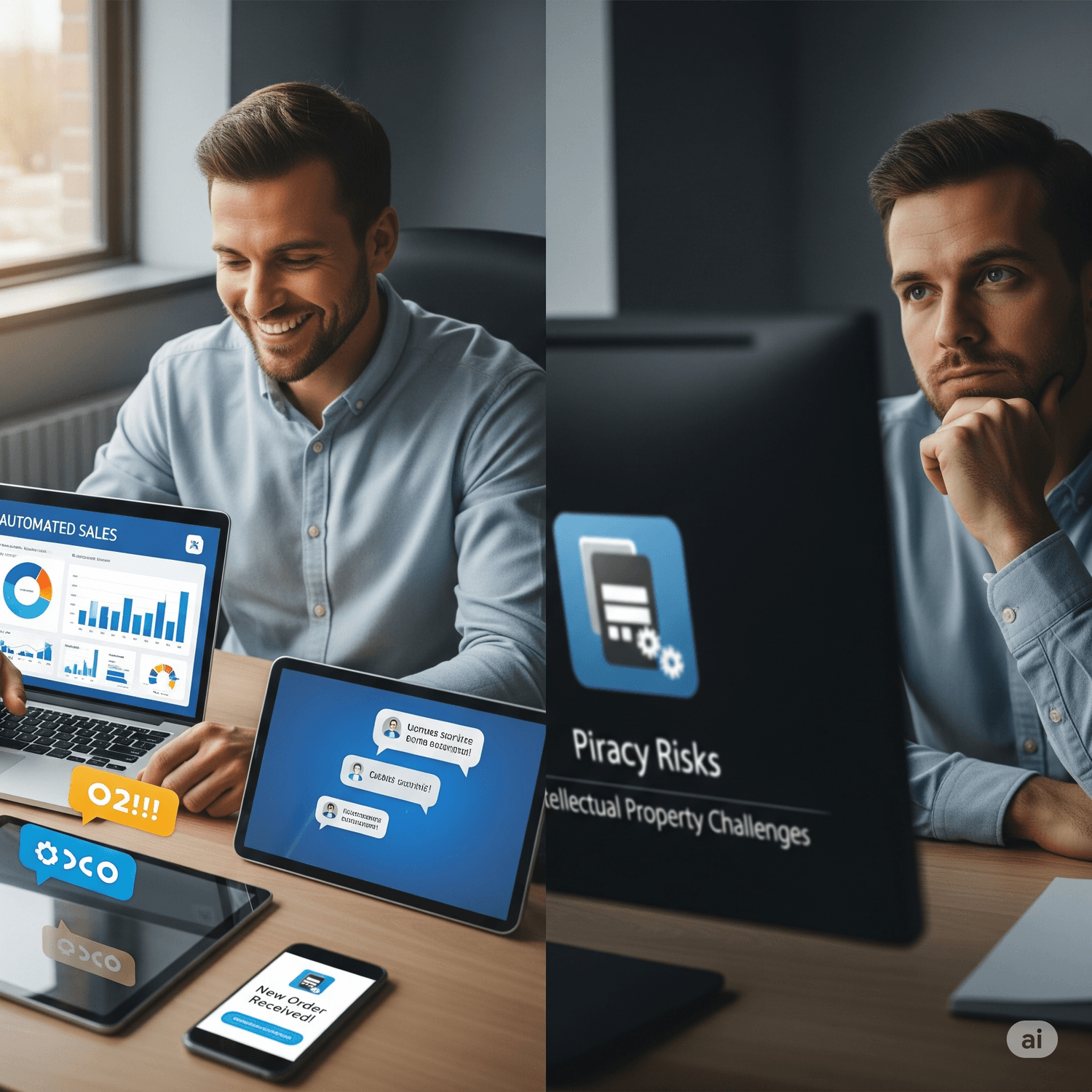Digital Products vs Physical Products: Which Business Model Should You Choose?
Welcome to the modern creator economy — where anyone with a laptop, internet connection, and a spark of creativity can launch a business from their bedroom. Whether you're an artist, a fitness coach, a software developer, or just someone with a good idea, the question eventually comes up:
Should I sell digital products or physical products?
Spoiler alert: there's no one-size-fits-all answer. And anyone who says otherwise is probably trying to sell you something.
This article is here to give you a realistic, unbiased comparison between digital vs physical product businesses — breaking down the facts, the pros and cons, and what it really takes to succeed in each. We'll look at profit potential, scalability, tools, and more, so you can make the right decision based on your skills, goals, and resources.
👉 Think of it as your business blueprint, not a hype-fueled sales pitch.
By the end, you’ll have a much clearer sense of which model aligns with your strengths, whether you're launching your first side hustle or pivoting into full-time entrepreneurship.
Ready to find your path? Let’s dive in.
What Are Digital Products?

Let’s start with the intangibles — digital products.
Digital products are non-physical goods that can be downloaded, streamed, or accessed online. They exist entirely in the digital space, meaning there’s no shipping, packaging, or physical inventory involved.
Common Examples Include:
eBooks
Online courses
Design templates
Mobile or desktop apps
Digital licenses (software, fonts, plugins)
Memberships or subscriptions to exclusive content
Printable planners or journals
If it lives in your computer and can be sold online — it’s a digital product.
Who Typically Sells Digital Products?
You’ll find solopreneurs, content creators, educators, and SaaS startups dominating this space.
Think:
A designer selling Canva templates on Etsy
A coach offering a fitness program through Gumroad
A programmer launching a micro SaaS tool
A writer selling PDF guides to grow an email list
The barrier to entry is low, which makes digital products attractive — but that also means the competition is fierce.
Popular Platforms for Digital Products:
Gumroad – great for creators and simple files
Teachable / Thinkific – perfect for online courses
Etsy (yes, it supports digital downloads!)
Shopify – with digital delivery apps installed
Podia, Payhip, Lemon Squeezy – rising options in the creator economy
Whether you want to build a passive income stream or launch a lean startup, digital products offer flexibility and scalability — but they also demand strong marketing, trust-building, and the ability to stand out in a crowded market.
What Are Physical Products?

Now onto the tangible side of eCommerce — physical products.
Physical products are goods you can touch, hold, wear, or use in the real world. Unlike digital files, they require manufacturing, shipping, and inventory management (unless you outsource those steps — more on that soon).
Common Examples Include:
Clothing and fashion accessories
Gadgets and electronics
Supplements or wellness products
Home decor
Fitness gear
Custom merchandise
If you can pack it in a box, it’s a physical product.
Business Models for Selling Physical Goods:
There’s no one way to run a physical product business — you’ve got options depending on your budget and risk appetite:
Dropshipping – You sell, someone else fulfills
Print-on-demand – Custom designs printed as orders come in
Private label – You brand existing products from suppliers
Amazon FBA – You send inventory to Amazon; they handle logistics
Inventory-based eCommerce – You manage everything yourself
Each model has its pros and cons, which we’ll explore later. But for now, just know that physical products often require more upfront capital, but they also allow for tangible brand experiences and repeat buyers.
Popular Platforms for Physical Product Businesses:
Shopify – Full control over branding and customer experience
Amazon – Huge traffic, but competitive and fee-heavy
Etsy – Great for handmade or niche items
eBay – Still powerful for collectibles, refurbished tech, and more
WooCommerce – WordPress-based store flexibility
Physical products might feel more “traditional,” but the tools and automation available today make this model more accessible than ever — even for one-person businesses.
Pros and Cons: Digital Products

Let’s talk about the digital side of the coin.
When you sell a digital product, you're essentially packaging knowledge, creativity, or utility into a format that can be delivered instantly. Sounds dreamy? It can be — but it’s not all sunshine and passive income.
✅ Advantages of Digital Products
High profit margins: Since there’s no cost per unit after creation, most of what you earn is pure profit. Sell it once or a thousand times — your cost stays the same.
Instant delivery: No need to worry about shipping times or lost packages. The product lands in your customer's inbox the second they hit "Buy."
Scalable without limits: Whether you get 10 orders or 10,000, your delivery system doesn’t break a sweat. Scaling becomes a matter of traffic and systems — not warehouses or staff.
Zero inventory or storage hassle: You don’t need to rent storage units or fill your garage with boxes.
Automation-friendly: With platforms like Gumroad, Teachable, or Shopify (digital setup), you can automate payments, delivery, email sequences, and even upsells.
❌ Disadvantages of Digital Products
Piracy and illegal sharing: One of the downsides of digital goods? They can be copied and redistributed without your permission. Unless you’re protecting your content carefully, this can be a serious issue.
Lower perceived value: Many buyers associate physical goods with higher value. A $50 online course might be seen as “too expensive,” while a $50 hoodie feels like a fair deal.
Requires trust and authority: People don't just buy information anymore — they buy trust. Unless you're an established expert or brand, convincing users to buy can be challenging.
Saturated markets: The low barrier to entry means the internet is flooded with low-effort eBooks, copy-paste Canva templates, and "meh" mini-courses. Standing out takes effort, originality, and quality.
Pros and Cons: Physical Products

Now, let’s switch gears and talk about selling physical products — the more “traditional” path, but still massively relevant (and profitable) today.
✅ Advantages of Physical Products
Tangible value: There’s something powerful about holding a product in your hands. For many customers, physical items feel more “real” and trustworthy.
Easier upsells: Selling a t-shirt? Offer a matching cap. Selling coffee beans? Throw in a branded mug. Upselling is intuitive in the physical product world.
Endless niche options: From eco-friendly pet toys to custom keyboards, the number of niches is staggering. If you find the right angle, you can build a product line that hits deep.
Stronger brand loyalty: Physical brands often create emotional connections. Think about your favorite clothing brand or tech gadget. People remember the experience.
❌ Disadvantages of Physical Products
Logistics and fulfillment headaches: Someone has to store, pack, ship, and track these items — and that someone is either you or someone you’re paying.
Lower profit margins: Between manufacturing, shipping, platform fees, and returns, profits can shrink fast — especially if you’re using dropshipping or print-on-demand.
Returns and customer issues: Broken packages, incorrect sizes, delayed deliveries... if you’ve sold anything physical, you know the drill.
Scaling is harder: While digital products scale with clicks, physical businesses scale with teams, warehouses, and operations. It can be done — but it’s a steeper climb.
How to Grow in the Digital Product Space

Growing in the digital product world isn’t about luck — it’s about positioning yourself as a trusted expert and building smart systems.
Let’s break it down:
✅ Focus on Expertise, Authority, and Content Marketing: People buy digital products from those they trust. Start by creating educational content on platforms like YouTube, Medium, or TikTok. Demonstrate your knowledge and share insights freely — it builds your reputation over time.
✅ Build an Email List: Email is still king when it comes to selling digital goods. Offer a freebie (like a mini eBook, checklist, or demo) in exchange for a user’s email, then nurture that list with valuable content and product offers.
✅ Use Platforms That Do the Heavy Lifting: Don’t reinvent the wheel. Platforms like Gumroad, Podia, Teachable, or Udemy help you host, sell, and distribute your products with built-in payment and delivery systems.
✅ Create High-Value, Evergreen Content: Want sales while you sleep? Invest in digital products that solve timeless problems. Courses, templates, or toolkits that help people save time, make money, or learn skills tend to sell long after launch day.
✅ Leverage Automation: From email sequences to checkout flows, use tools like Zapier, ConvertKit, or Systeme.io to automate repetitive tasks — so you can focus on creating and scaling.
Pro tip: Bundle your offers to increase average order value without increasing workload.
How to Grow in the Physical Product Space

Scaling a physical product business requires marketing chops, operational savvy, and a real understanding of your audience.
Here’s how to thrive:
✅ Niche Research + Product-Market Fit: Before launching anything, make sure there’s actual demand. Use tools like Google Trends, TikTok Creative Center, or Amazon reviews to find pain points or trending interests. Aim to be specific — don’t just sell “jewelry,” sell “minimalist rings for active women.”
✅ Strong Branding + Visual Marketing: Packaging, product photos, and video content matter more than you think. A bland product with strong branding often beats a great product with weak visuals. Platforms like Canva and Mojo can help you craft scroll-stopping assets.
✅ Leverage Influencers and UGC: Authentic reviews and unboxings build trust. Partner with micro-influencers or run campaigns to gather user-generated content (UGC) that showcases your product in real-world use.
✅ Focus on Fulfillment and Customer Experience: Speed and support go a long way. Use reliable 3PLs (third-party logistics) or Amazon FBA to ensure timely deliveries. Train your customer support to be responsive and helpful — happy customers = returning customers.
✅ Optimize for Social Platforms: TikTok and Instagram aren’t just for trends — they’re marketplaces. Create short, engaging product videos. Use trending audio, storytelling hooks, and call-to-actions (CTAs) like “Link in bio” or “Comment ‘YES’ for the link.”
Bonus tip: Limited-time offers and scarcity (e.g., “Only 10 left”) work especially well with physical products — just keep it honest.
Monetization Strategies for Physical & Digital Products

So, you’ve got a product idea — that’s the exciting first step. But how do you actually turn attention into income? Monetization is where the magic happens, and it varies depending on whether you’re selling digital or physical products.
If you’re still building your audience or want to learn how to create a steady income stream through content, be sure to check out our comprehensive guide on how to monetize with a blog. It’s packed with actionable tips on turning your blog or online presence into a profitable business.
Let’s dive into the proven monetization methods for both types of products:
Monetization for Digital Products
Digital products are perfect for creators, educators, coaches, and beginners with limited upfront investment. The flexibility and scalability here are huge advantages.
Direct sales: Sell eBooks, online courses, templates, or software licenses directly to your audience. Platforms like Systeme.io make this easy, especially for beginners. It’s an all-in-one tool that handles landing pages, sales funnels, email marketing, and payment processing — all without needing to code or hire a developer.
Subscriptions and memberships: Offer exclusive content, ongoing coaching, or community access via memberships. Recurring revenue from subscriptions can provide stable cash flow.
Upsells, bundles, and licensing: Once you have customers, offer upgraded versions of your digital products (“Pro” editions), bundles combining multiple items, or commercial licenses allowing others to resell your products.
Affiliate partnerships: Promote tools or platforms you trust, earning commissions from sales. This is a great way to diversify income without creating new products.
Beginner Tip: If you’re just starting out, Systeme.io is an excellent choice. It’s affordable, user-friendly, and scalable, perfect for building your digital product business step-by-step.
Monetization for Physical Products
If you love branding, packaging, and creating tangible experiences, physical products might be your path. Monetization here revolves around product diversity and customer loyalty.
Product bundles and seasonal offers: Package related items into starter kits or holiday gift boxes to increase average order value and attract repeat customers.
Subscriptions: Wellness products, apparel, or pet supplies often do well with subscription models, keeping customers engaged with regular deliveries.
Wholesale and private label deals: Once established, selling your products wholesale or under private label agreements can open retail or B2B channels, scaling your reach.
Influencer-driven drops: Collaborate with influencers for limited edition or co-branded products to create buzz and urgency.
No matter which route you choose, the key to successful monetization is building trust with your audience, delivering real value, and creating repeatable income streams. Make your customers feel like insiders and keep them coming back.
Who Should Choose What?

Choosing between digital and physical products can feel overwhelming, so let’s simplify it with a straightforward, scenario-based guide. This will help you figure out which business model fits your situation best — no fluff, no hype.
If you’re a beginner creator with no inventory budget:
→ Start with digital products.
Digital goods like eBooks, courses, or templates require little to no upfront investment beyond your time and skills. Plus, you can use tools like Systeme.io to create a free blog or landing page, build your email list, and start selling — all without the headaches of shipping or managing stock.
If you love branding and want a tangible, physical presence:
→ Explore physical products.
Creating a physical product can help you build a brand that customers can touch and feel, which many find more valuable and memorable. Keep in mind, this path often requires upfront investment in inventory, design, packaging, and fulfillment. However, starting with models like dropshipping or print-on-demand can lower the barrier to entry and let you test ideas without large risks.
If you want flexibility and long-term growth:
→ Try a hybrid model.
Many successful creators combine the best of both worlds: selling digital and physical products side-by-side. For example:
A fitness creator sells an online training course alongside branded workout equipment.
A journaling brand offers digital planners and physical notebooks.
A blogger shares free content, promotes affiliate products, and sells their own digital guides or merchandise.
Choose what aligns with your unique skills, budget, and audience. Start where you feel strongest, learn as you go, and build your business step-by-step. The best model is the one you can commit to and grow sustainably.
Final Thoughts

Both digital and physical product businesses have clear paths to success—but here’s the honest truth: nothing worthwhile happens overnight. Building a profitable venture takes consistency, patience, and persistent effort over months (sometimes even years).
You might hear about overnight successes, but the reality is that real growth begins when you stop jumping from one shiny opportunity to the next and instead commit fully to a clear strategy. Whether you choose digital, physical, or a hybrid model, the key is to focus deeply, learn continuously, and adapt without losing sight of your core goals.
Expect slow beginnings. Your first sales, your first loyal customers, or your first scalable system may take time to develop — but that’s normal. What separates successful creators and entrepreneurs from the rest is their ability to keep showing up, improve bit by bit, and push through challenges.
So before you dive in, reflect honestly on your strengths, resources, and long-term vision. Pick the model that fits you best and stick with it. Build steadily, measure your progress, and remember: success is a marathon, not a sprint.
In the end, your dedication to a focused, well-planned approach will be what transforms your ideas into a sustainable, thriving business.
Did this article bring you value?
We'd love to hear your thoughts. Your feedback isn’t just appreciated — it helps us create better content, tailored to what matters most to you.
Click here to share your feedback — it only takes a moment, and it makes a big difference.
Don't Miss What Works
Get our best strategies, tool reviews, and deep-dive guides delivered straight to your inbox. No hype, just proven insights.
Created with © systeme.io • Privacy policy • Terms of service


